Business Environment Analysis of British Airways - Semester 1 Report
VerifiedAdded on 2020/01/28
|12
|4455
|399
Report
AI Summary
This report provides a comprehensive business environment analysis of British Airways. It begins with an introduction to the company and its objectives, followed by an examination of how the organization meets the objectives of its various stakeholders, including employees, suppliers, customers, and the environment. The report then delves into the economic systems that impact the airline, including free, mixed, and centrally planned economies, and analyzes the effects of fiscal and monetary policies. The analysis extends to market structures, pricing and output decisions, and the impact of competition and regulatory mechanisms on British Airways. Finally, the report explores the significance of international trade, global factors, and European Union policies on the company, culminating in a conclusion that summarizes the key findings and recommendations.
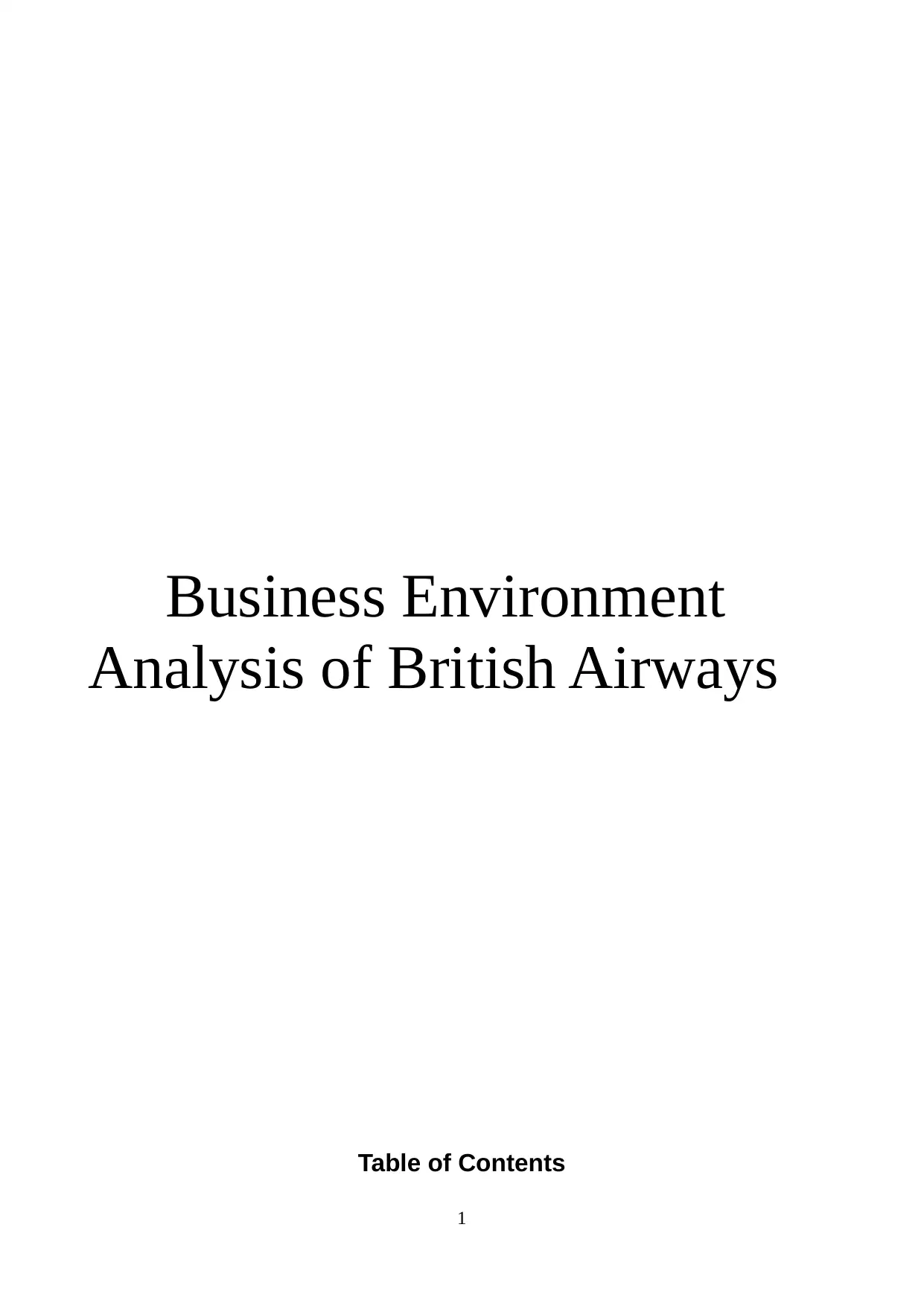
Business Environment
Analysis of British Airways
Table of Contents
1
Analysis of British Airways
Table of Contents
1
Paraphrase This Document
Need a fresh take? Get an instant paraphrase of this document with our AI Paraphraser
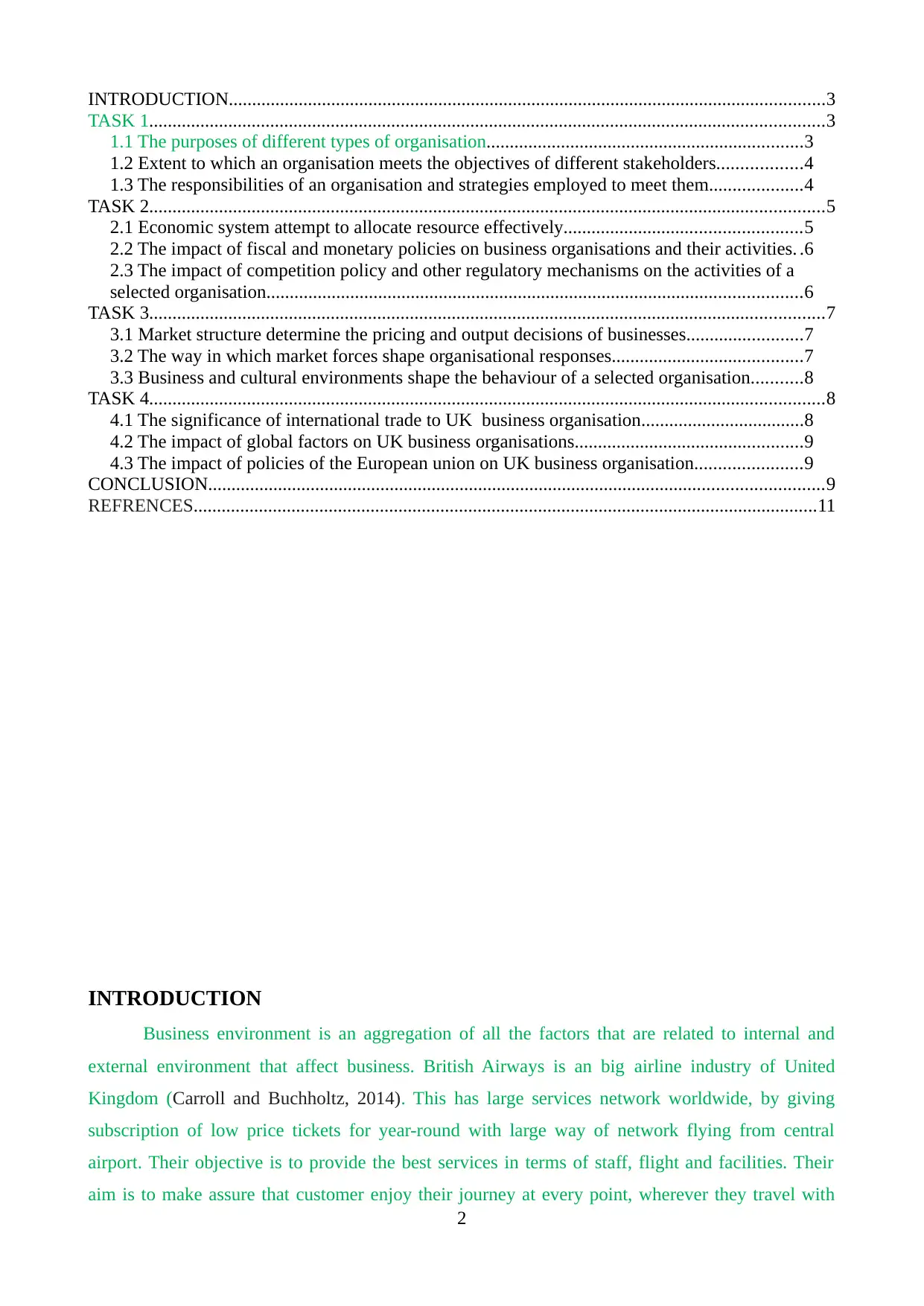
INTRODUCTION................................................................................................................................3
TASK 1.................................................................................................................................................3
1.1 The purposes of different types of organisation....................................................................3
1.2 Extent to which an organisation meets the objectives of different stakeholders..................4
1.3 The responsibilities of an organisation and strategies employed to meet them....................4
TASK 2.................................................................................................................................................5
2.1 Economic system attempt to allocate resource effectively...................................................5
2.2 The impact of fiscal and monetary policies on business organisations and their activities. .6
2.3 The impact of competition policy and other regulatory mechanisms on the activities of a
selected organisation...................................................................................................................6
TASK 3.................................................................................................................................................7
3.1 Market structure determine the pricing and output decisions of businesses.........................7
3.2 The way in which market forces shape organisational responses.........................................7
3.3 Business and cultural environments shape the behaviour of a selected organisation...........8
TASK 4.................................................................................................................................................8
4.1 The significance of international trade to UK business organisation...................................8
4.2 The impact of global factors on UK business organisations.................................................9
4.3 The impact of policies of the European union on UK business organisation.......................9
CONCLUSION....................................................................................................................................9
REFRENCES......................................................................................................................................11
INTRODUCTION
Business environment is an aggregation of all the factors that are related to internal and
external environment that affect business. British Airways is an big airline industry of United
Kingdom (Carroll and Buchholtz, 2014). This has large services network worldwide, by giving
subscription of low price tickets for year-round with large way of network flying from central
airport. Their objective is to provide the best services in terms of staff, flight and facilities. Their
aim is to make assure that customer enjoy their journey at every point, wherever they travel with
2
TASK 1.................................................................................................................................................3
1.1 The purposes of different types of organisation....................................................................3
1.2 Extent to which an organisation meets the objectives of different stakeholders..................4
1.3 The responsibilities of an organisation and strategies employed to meet them....................4
TASK 2.................................................................................................................................................5
2.1 Economic system attempt to allocate resource effectively...................................................5
2.2 The impact of fiscal and monetary policies on business organisations and their activities. .6
2.3 The impact of competition policy and other regulatory mechanisms on the activities of a
selected organisation...................................................................................................................6
TASK 3.................................................................................................................................................7
3.1 Market structure determine the pricing and output decisions of businesses.........................7
3.2 The way in which market forces shape organisational responses.........................................7
3.3 Business and cultural environments shape the behaviour of a selected organisation...........8
TASK 4.................................................................................................................................................8
4.1 The significance of international trade to UK business organisation...................................8
4.2 The impact of global factors on UK business organisations.................................................9
4.3 The impact of policies of the European union on UK business organisation.......................9
CONCLUSION....................................................................................................................................9
REFRENCES......................................................................................................................................11
INTRODUCTION
Business environment is an aggregation of all the factors that are related to internal and
external environment that affect business. British Airways is an big airline industry of United
Kingdom (Carroll and Buchholtz, 2014). This has large services network worldwide, by giving
subscription of low price tickets for year-round with large way of network flying from central
airport. Their objective is to provide the best services in terms of staff, flight and facilities. Their
aim is to make assure that customer enjoy their journey at every point, wherever they travel with
2
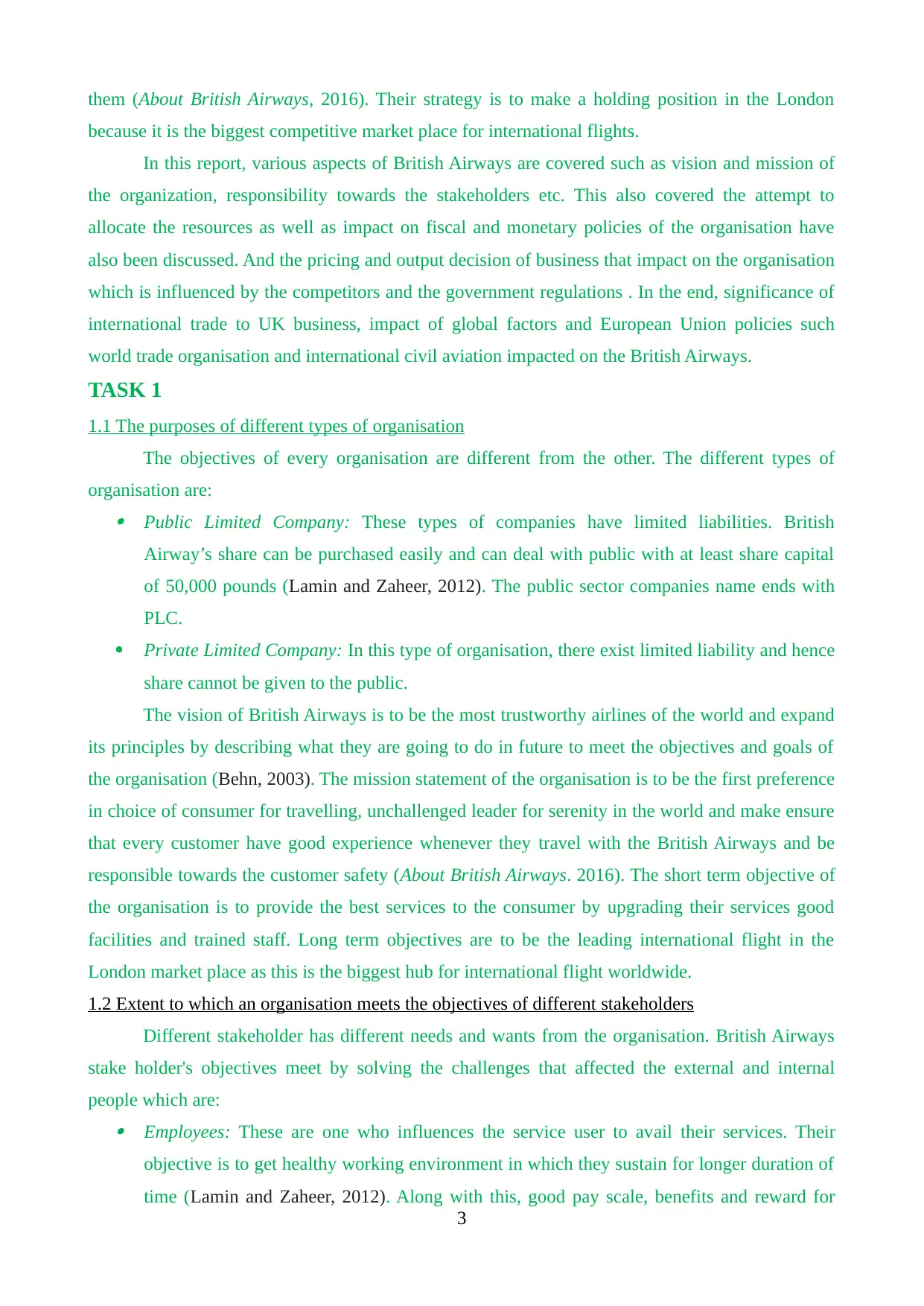
them (About British Airways, 2016). Their strategy is to make a holding position in the London
because it is the biggest competitive market place for international flights.
In this report, various aspects of British Airways are covered such as vision and mission of
the organization, responsibility towards the stakeholders etc. This also covered the attempt to
allocate the resources as well as impact on fiscal and monetary policies of the organisation have
also been discussed. And the pricing and output decision of business that impact on the organisation
which is influenced by the competitors and the government regulations . In the end, significance of
international trade to UK business, impact of global factors and European Union policies such
world trade organisation and international civil aviation impacted on the British Airways.
TASK 1
1.1 The purposes of different types of organisation
The objectives of every organisation are different from the other. The different types of
organisation are: Public Limited Company: These types of companies have limited liabilities. British
Airway’s share can be purchased easily and can deal with public with at least share capital
of 50,000 pounds (Lamin and Zaheer, 2012). The public sector companies name ends with
PLC.
Private Limited Company: In this type of organisation, there exist limited liability and hence
share cannot be given to the public.
The vision of British Airways is to be the most trustworthy airlines of the world and expand
its principles by describing what they are going to do in future to meet the objectives and goals of
the organisation (Behn, 2003). The mission statement of the organisation is to be the first preference
in choice of consumer for travelling, unchallenged leader for serenity in the world and make ensure
that every customer have good experience whenever they travel with the British Airways and be
responsible towards the customer safety (About British Airways. 2016). The short term objective of
the organisation is to provide the best services to the consumer by upgrading their services good
facilities and trained staff. Long term objectives are to be the leading international flight in the
London market place as this is the biggest hub for international flight worldwide.
1.2 Extent to which an organisation meets the objectives of different stakeholders
Different stakeholder has different needs and wants from the organisation. British Airways
stake holder's objectives meet by solving the challenges that affected the external and internal
people which are: Employees: These are one who influences the service user to avail their services. Their
objective is to get healthy working environment in which they sustain for longer duration of
time (Lamin and Zaheer, 2012). Along with this, good pay scale, benefits and reward for
3
because it is the biggest competitive market place for international flights.
In this report, various aspects of British Airways are covered such as vision and mission of
the organization, responsibility towards the stakeholders etc. This also covered the attempt to
allocate the resources as well as impact on fiscal and monetary policies of the organisation have
also been discussed. And the pricing and output decision of business that impact on the organisation
which is influenced by the competitors and the government regulations . In the end, significance of
international trade to UK business, impact of global factors and European Union policies such
world trade organisation and international civil aviation impacted on the British Airways.
TASK 1
1.1 The purposes of different types of organisation
The objectives of every organisation are different from the other. The different types of
organisation are: Public Limited Company: These types of companies have limited liabilities. British
Airway’s share can be purchased easily and can deal with public with at least share capital
of 50,000 pounds (Lamin and Zaheer, 2012). The public sector companies name ends with
PLC.
Private Limited Company: In this type of organisation, there exist limited liability and hence
share cannot be given to the public.
The vision of British Airways is to be the most trustworthy airlines of the world and expand
its principles by describing what they are going to do in future to meet the objectives and goals of
the organisation (Behn, 2003). The mission statement of the organisation is to be the first preference
in choice of consumer for travelling, unchallenged leader for serenity in the world and make ensure
that every customer have good experience whenever they travel with the British Airways and be
responsible towards the customer safety (About British Airways. 2016). The short term objective of
the organisation is to provide the best services to the consumer by upgrading their services good
facilities and trained staff. Long term objectives are to be the leading international flight in the
London market place as this is the biggest hub for international flight worldwide.
1.2 Extent to which an organisation meets the objectives of different stakeholders
Different stakeholder has different needs and wants from the organisation. British Airways
stake holder's objectives meet by solving the challenges that affected the external and internal
people which are: Employees: These are one who influences the service user to avail their services. Their
objective is to get healthy working environment in which they sustain for longer duration of
time (Lamin and Zaheer, 2012). Along with this, good pay scale, benefits and reward for
3
⊘ This is a preview!⊘
Do you want full access?
Subscribe today to unlock all pages.

Trusted by 1+ million students worldwide
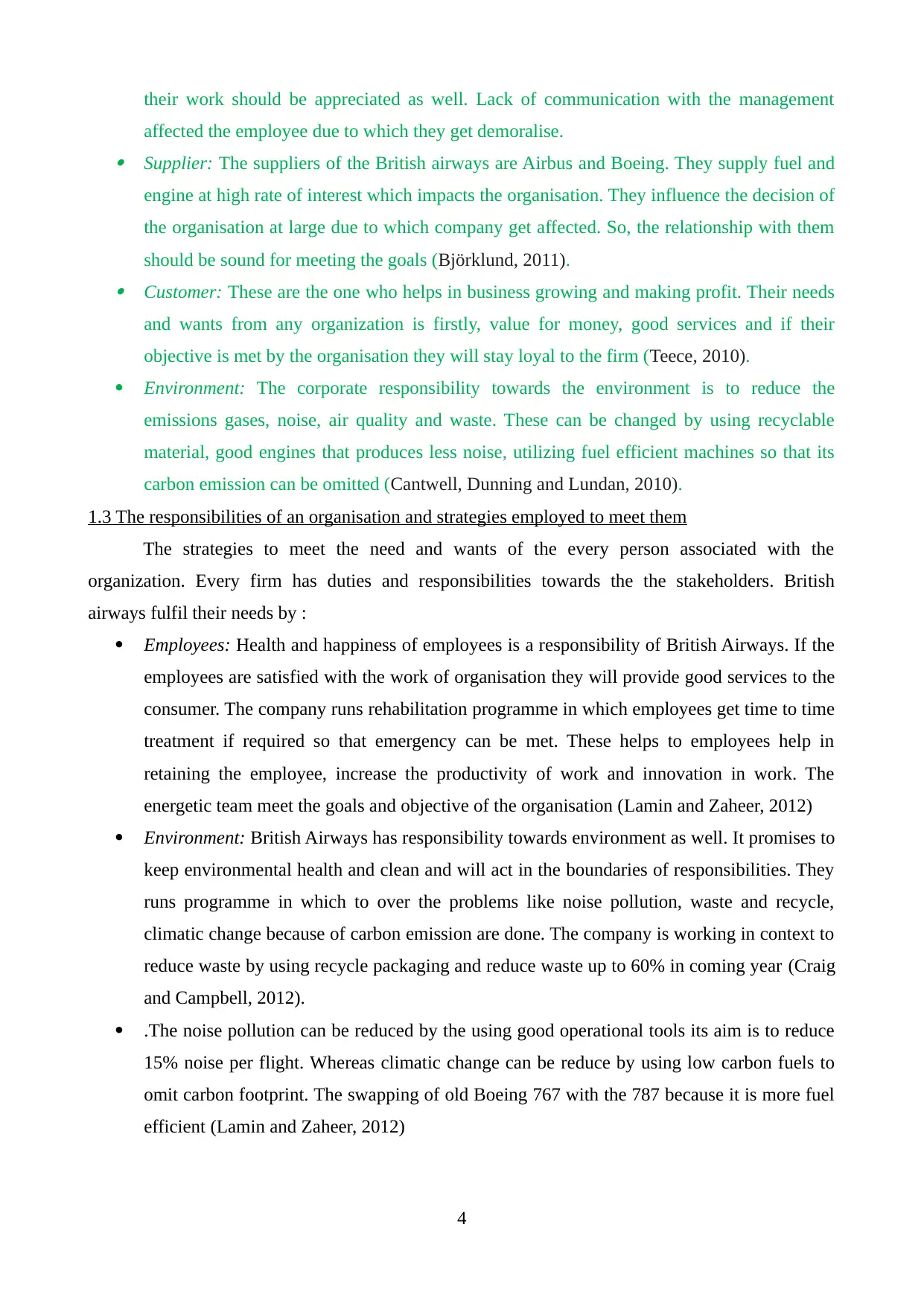
their work should be appreciated as well. Lack of communication with the management
affected the employee due to which they get demoralise. Supplier: The suppliers of the British airways are Airbus and Boeing. They supply fuel and
engine at high rate of interest which impacts the organisation. They influence the decision of
the organisation at large due to which company get affected. So, the relationship with them
should be sound for meeting the goals (Björklund, 2011). Customer: These are the one who helps in business growing and making profit. Their needs
and wants from any organization is firstly, value for money, good services and if their
objective is met by the organisation they will stay loyal to the firm (Teece, 2010).
Environment: The corporate responsibility towards the environment is to reduce the
emissions gases, noise, air quality and waste. These can be changed by using recyclable
material, good engines that produces less noise, utilizing fuel efficient machines so that its
carbon emission can be omitted (Cantwell, Dunning and Lundan, 2010).
1.3 The responsibilities of an organisation and strategies employed to meet them
The strategies to meet the need and wants of the every person associated with the
organization. Every firm has duties and responsibilities towards the the stakeholders. British
airways fulfil their needs by :
Employees: Health and happiness of employees is a responsibility of British Airways. If the
employees are satisfied with the work of organisation they will provide good services to the
consumer. The company runs rehabilitation programme in which employees get time to time
treatment if required so that emergency can be met. These helps to employees help in
retaining the employee, increase the productivity of work and innovation in work. The
energetic team meet the goals and objective of the organisation (Lamin and Zaheer, 2012)
Environment: British Airways has responsibility towards environment as well. It promises to
keep environmental health and clean and will act in the boundaries of responsibilities. They
runs programme in which to over the problems like noise pollution, waste and recycle,
climatic change because of carbon emission are done. The company is working in context to
reduce waste by using recycle packaging and reduce waste up to 60% in coming year (Craig
and Campbell, 2012).
.The noise pollution can be reduced by the using good operational tools its aim is to reduce
15% noise per flight. Whereas climatic change can be reduce by using low carbon fuels to
omit carbon footprint. The swapping of old Boeing 767 with the 787 because it is more fuel
efficient (Lamin and Zaheer, 2012)
4
affected the employee due to which they get demoralise. Supplier: The suppliers of the British airways are Airbus and Boeing. They supply fuel and
engine at high rate of interest which impacts the organisation. They influence the decision of
the organisation at large due to which company get affected. So, the relationship with them
should be sound for meeting the goals (Björklund, 2011). Customer: These are the one who helps in business growing and making profit. Their needs
and wants from any organization is firstly, value for money, good services and if their
objective is met by the organisation they will stay loyal to the firm (Teece, 2010).
Environment: The corporate responsibility towards the environment is to reduce the
emissions gases, noise, air quality and waste. These can be changed by using recyclable
material, good engines that produces less noise, utilizing fuel efficient machines so that its
carbon emission can be omitted (Cantwell, Dunning and Lundan, 2010).
1.3 The responsibilities of an organisation and strategies employed to meet them
The strategies to meet the need and wants of the every person associated with the
organization. Every firm has duties and responsibilities towards the the stakeholders. British
airways fulfil their needs by :
Employees: Health and happiness of employees is a responsibility of British Airways. If the
employees are satisfied with the work of organisation they will provide good services to the
consumer. The company runs rehabilitation programme in which employees get time to time
treatment if required so that emergency can be met. These helps to employees help in
retaining the employee, increase the productivity of work and innovation in work. The
energetic team meet the goals and objective of the organisation (Lamin and Zaheer, 2012)
Environment: British Airways has responsibility towards environment as well. It promises to
keep environmental health and clean and will act in the boundaries of responsibilities. They
runs programme in which to over the problems like noise pollution, waste and recycle,
climatic change because of carbon emission are done. The company is working in context to
reduce waste by using recycle packaging and reduce waste up to 60% in coming year (Craig
and Campbell, 2012).
.The noise pollution can be reduced by the using good operational tools its aim is to reduce
15% noise per flight. Whereas climatic change can be reduce by using low carbon fuels to
omit carbon footprint. The swapping of old Boeing 767 with the 787 because it is more fuel
efficient (Lamin and Zaheer, 2012)
4
Paraphrase This Document
Need a fresh take? Get an instant paraphrase of this document with our AI Paraphraser

TASK 2
2.1 Economic system attempt to allocate resource effectively
Economic system that attempt to allocate resources effectively in the country are through
free market, mixed market and centrally planned. Free Economic system: In this market system, price is decided according to the demand in
the market (Trkman, 2010). The government is neglected or involved less in this economic
system. For example, in season like summer, people prefer to visit more for vacation so the
fare price are increased by the British airways (Lamin and Zaheer, 2012). Mixed Economic system: These system is mixed of all the economic system. In which
socialism and capitalism are there is known as Mixed economic system. Private sector are
more likely involved in this system because its helps them in getting more profit for the
nation (Carroll and Shabana, 2010). The resource available are disturbed among the private
and government sector.
Centrally Planned Economic system: In this economic system government plan all the
activities related to the economy. Private sector do not involve themselves in any
economical accretion (Nandakumar, Ghobadian and O'Regan, 2010). Unemployment is not
meet in this system because government plan and allocate the resource according to the
need of worker.
The British Airways adopt Free Economic system in which there is least involvement of the
government. In these sector the resources comes under the private sector and market. As they can
decide the price and other mechanisms on the basis of the demand and supply (Kessler and Frank,
2009). They can plan and take decision of the basis of the consumer response as they can increase
fare rate in vacation and decrease the price in the off season. Raise the productivity as per the need
and profit margin of the company (Lamin and Zaheer, 2012).
2.2 The impact of fiscal and monetary policies on business organisations and their activities
The impact of fiscal and monetary policy on British Airways can be analysed. Fiscal policy
are those from which government has an impact on spending and tax affect on the demand. If the
government wants to restorative the growth of the economy , then goods and services spending are
increased (Kessler and Frank, 2009). Similarly, if the demand is increasing beyond the boundary
line the government will decrease the spending , due to this there is over all decrement in the the
economy. The British airways gets impacted because of these fiscal changes such as the profit of the
company decreases, demand of the flights travel decreases, the unemployment occurs (Lamin and
Zaheer, 2012).
On the contrary, the monetary policy influence the demand and supply due to change in
interest rates and tools of monetary policy, the important tool is interest rate (Sim and Teoh, 2011).
5
2.1 Economic system attempt to allocate resource effectively
Economic system that attempt to allocate resources effectively in the country are through
free market, mixed market and centrally planned. Free Economic system: In this market system, price is decided according to the demand in
the market (Trkman, 2010). The government is neglected or involved less in this economic
system. For example, in season like summer, people prefer to visit more for vacation so the
fare price are increased by the British airways (Lamin and Zaheer, 2012). Mixed Economic system: These system is mixed of all the economic system. In which
socialism and capitalism are there is known as Mixed economic system. Private sector are
more likely involved in this system because its helps them in getting more profit for the
nation (Carroll and Shabana, 2010). The resource available are disturbed among the private
and government sector.
Centrally Planned Economic system: In this economic system government plan all the
activities related to the economy. Private sector do not involve themselves in any
economical accretion (Nandakumar, Ghobadian and O'Regan, 2010). Unemployment is not
meet in this system because government plan and allocate the resource according to the
need of worker.
The British Airways adopt Free Economic system in which there is least involvement of the
government. In these sector the resources comes under the private sector and market. As they can
decide the price and other mechanisms on the basis of the demand and supply (Kessler and Frank,
2009). They can plan and take decision of the basis of the consumer response as they can increase
fare rate in vacation and decrease the price in the off season. Raise the productivity as per the need
and profit margin of the company (Lamin and Zaheer, 2012).
2.2 The impact of fiscal and monetary policies on business organisations and their activities
The impact of fiscal and monetary policy on British Airways can be analysed. Fiscal policy
are those from which government has an impact on spending and tax affect on the demand. If the
government wants to restorative the growth of the economy , then goods and services spending are
increased (Kessler and Frank, 2009). Similarly, if the demand is increasing beyond the boundary
line the government will decrease the spending , due to this there is over all decrement in the the
economy. The British airways gets impacted because of these fiscal changes such as the profit of the
company decreases, demand of the flights travel decreases, the unemployment occurs (Lamin and
Zaheer, 2012).
On the contrary, the monetary policy influence the demand and supply due to change in
interest rates and tools of monetary policy, the important tool is interest rate (Sim and Teoh, 2011).
5
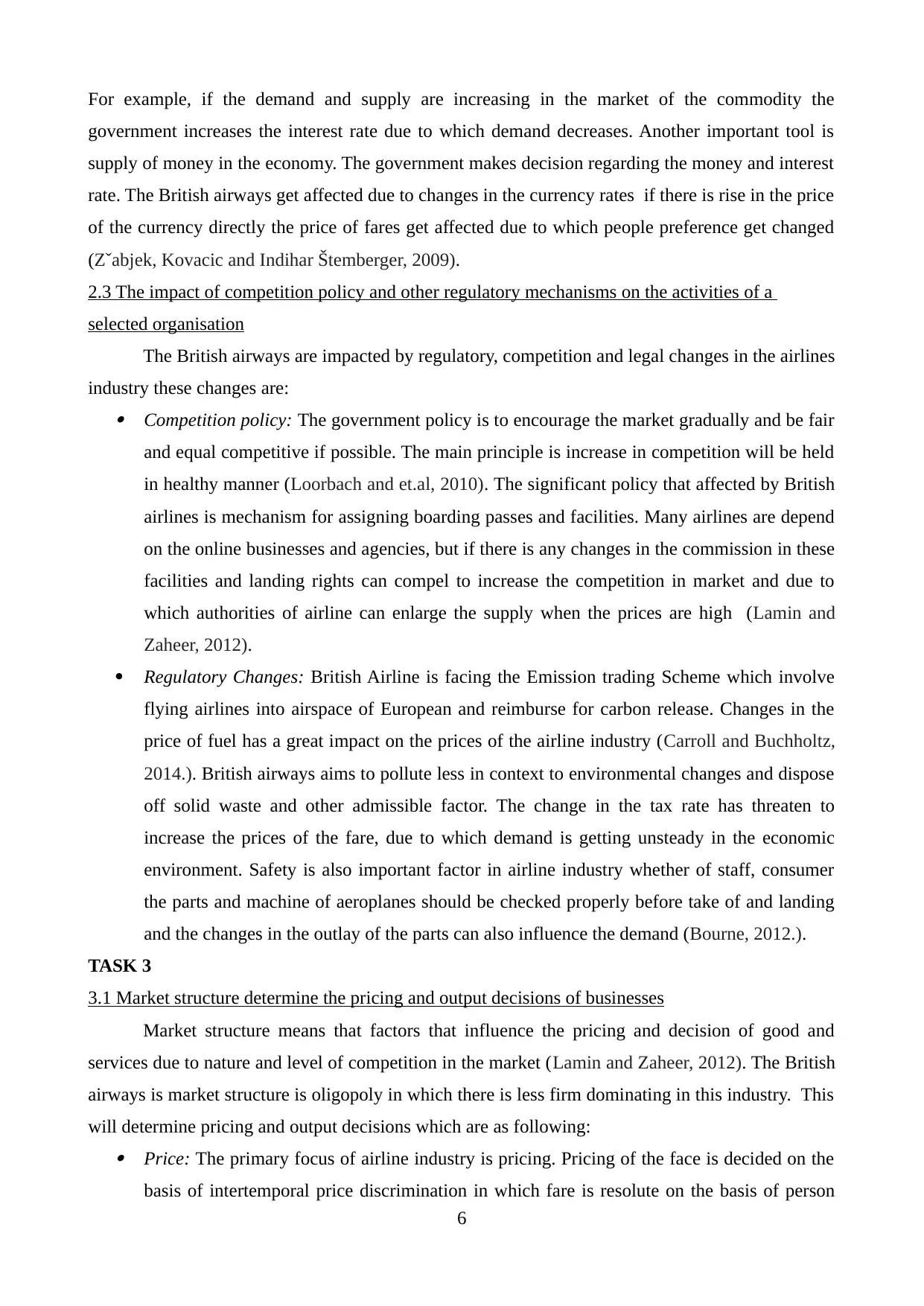
For example, if the demand and supply are increasing in the market of the commodity the
government increases the interest rate due to which demand decreases. Another important tool is
supply of money in the economy. The government makes decision regarding the money and interest
rate. The British airways get affected due to changes in the currency rates if there is rise in the price
of the currency directly the price of fares get affected due to which people preference get changed
(Zˇabjek, Kovacic and Indihar Štemberger, 2009).
2.3 The impact of competition policy and other regulatory mechanisms on the activities of a
selected organisation
The British airways are impacted by regulatory, competition and legal changes in the airlines
industry these changes are: Competition policy: The government policy is to encourage the market gradually and be fair
and equal competitive if possible. The main principle is increase in competition will be held
in healthy manner (Loorbach and et.al, 2010). The significant policy that affected by British
airlines is mechanism for assigning boarding passes and facilities. Many airlines are depend
on the online businesses and agencies, but if there is any changes in the commission in these
facilities and landing rights can compel to increase the competition in market and due to
which authorities of airline can enlarge the supply when the prices are high (Lamin and
Zaheer, 2012).
Regulatory Changes: British Airline is facing the Emission trading Scheme which involve
flying airlines into airspace of European and reimburse for carbon release. Changes in the
price of fuel has a great impact on the prices of the airline industry (Carroll and Buchholtz,
2014.). British airways aims to pollute less in context to environmental changes and dispose
off solid waste and other admissible factor. The change in the tax rate has threaten to
increase the prices of the fare, due to which demand is getting unsteady in the economic
environment. Safety is also important factor in airline industry whether of staff, consumer
the parts and machine of aeroplanes should be checked properly before take of and landing
and the changes in the outlay of the parts can also influence the demand (Bourne, 2012.).
TASK 3
3.1 Market structure determine the pricing and output decisions of businesses
Market structure means that factors that influence the pricing and decision of good and
services due to nature and level of competition in the market (Lamin and Zaheer, 2012). The British
airways is market structure is oligopoly in which there is less firm dominating in this industry. This
will determine pricing and output decisions which are as following: Price: The primary focus of airline industry is pricing. Pricing of the face is decided on the
basis of intertemporal price discrimination in which fare is resolute on the basis of person
6
government increases the interest rate due to which demand decreases. Another important tool is
supply of money in the economy. The government makes decision regarding the money and interest
rate. The British airways get affected due to changes in the currency rates if there is rise in the price
of the currency directly the price of fares get affected due to which people preference get changed
(Zˇabjek, Kovacic and Indihar Štemberger, 2009).
2.3 The impact of competition policy and other regulatory mechanisms on the activities of a
selected organisation
The British airways are impacted by regulatory, competition and legal changes in the airlines
industry these changes are: Competition policy: The government policy is to encourage the market gradually and be fair
and equal competitive if possible. The main principle is increase in competition will be held
in healthy manner (Loorbach and et.al, 2010). The significant policy that affected by British
airlines is mechanism for assigning boarding passes and facilities. Many airlines are depend
on the online businesses and agencies, but if there is any changes in the commission in these
facilities and landing rights can compel to increase the competition in market and due to
which authorities of airline can enlarge the supply when the prices are high (Lamin and
Zaheer, 2012).
Regulatory Changes: British Airline is facing the Emission trading Scheme which involve
flying airlines into airspace of European and reimburse for carbon release. Changes in the
price of fuel has a great impact on the prices of the airline industry (Carroll and Buchholtz,
2014.). British airways aims to pollute less in context to environmental changes and dispose
off solid waste and other admissible factor. The change in the tax rate has threaten to
increase the prices of the fare, due to which demand is getting unsteady in the economic
environment. Safety is also important factor in airline industry whether of staff, consumer
the parts and machine of aeroplanes should be checked properly before take of and landing
and the changes in the outlay of the parts can also influence the demand (Bourne, 2012.).
TASK 3
3.1 Market structure determine the pricing and output decisions of businesses
Market structure means that factors that influence the pricing and decision of good and
services due to nature and level of competition in the market (Lamin and Zaheer, 2012). The British
airways is market structure is oligopoly in which there is less firm dominating in this industry. This
will determine pricing and output decisions which are as following: Price: The primary focus of airline industry is pricing. Pricing of the face is decided on the
basis of intertemporal price discrimination in which fare is resolute on the basis of person
6
⊘ This is a preview!⊘
Do you want full access?
Subscribe today to unlock all pages.

Trusted by 1+ million students worldwide

need and wants of consumer like departure date, time, etc. every company has its own effect
in the market that's affects other company rates (Craig and Campbell, 2012). Demand: According to the need of consumer can also affect the decision of the British
airlines because the demand of the people in vacation gets high and in off season its reduces
(Aswathappa, 2009). Supply : As the demand get rises in vacation time so the flexibility should be there so that
modification can be done and can encourage people by giving offers and discounts so that
the can swap to the offer due to which supply in shortage do not get affected (Hamilton and
Webster, 2015).
Competition: The competitive airline can offer better benefits of the consumer to which they
get attracted. So the pricing should be kept in such as way that demand and supply of British
airline do not get pretentious (Lamin and Zaheer, 2012).
3.2 The way in which market forces shape organisational responses
The way in which market forces shape the organsational responses are the Market Forces
are the one who react collectively on the demand and supply in the emporium environment on the
fares of goods and services rendered. These forces increase the cost when the supply reduces and
demand exceed and vice versa. The competitive player of British Airways are Deutsche Lufthansa
AG, Japan airlines Co. LTD and United Airlines, INC. when these competitors changes the rate and
strategies of the selling the tickets due to which British Airways plans and policy get disturbed so
they adopt new agenda to be competitive in the market. The frame new goal such as keeping offer
with some other marketing tool so that people stay attracted and loyal to the services render to the
consumer (Lamin and Zaheer, 2012). The price are kept low in such a way that they can meet there
profit margin and sustain goodwill by giving good services.
The supply is decided by planning well and then schedule and meeting all the needs of the
consumer. If the supply went high, prices reduces as their profit margin are met so they keeping
changing their strategies so that they can be competitive in the marketplace (About British Airways.
2016). These are also overripe by the government laws and effect, as these can be imposed any time
so that should keep their pricing and keeping other aspects in mind.
3.3 Business and cultural environments shape the behaviour of a selected organisation
Business and cultural environments shape the behaviour of a selected organisation by the
impact of working practices and cultural of the countries. British airways are has impacted the
environment by providing the air transport. These committed to reduce the emission gases and also
reducing the environmental footprints (Matching capacity to demand, 2010). They have also
improve in the quality of noise and air pollution by investing in good technology. Noise are reduce
by the using quieter craft and change the ways of operating aircraft. Waste can be reduced by using
7
in the market that's affects other company rates (Craig and Campbell, 2012). Demand: According to the need of consumer can also affect the decision of the British
airlines because the demand of the people in vacation gets high and in off season its reduces
(Aswathappa, 2009). Supply : As the demand get rises in vacation time so the flexibility should be there so that
modification can be done and can encourage people by giving offers and discounts so that
the can swap to the offer due to which supply in shortage do not get affected (Hamilton and
Webster, 2015).
Competition: The competitive airline can offer better benefits of the consumer to which they
get attracted. So the pricing should be kept in such as way that demand and supply of British
airline do not get pretentious (Lamin and Zaheer, 2012).
3.2 The way in which market forces shape organisational responses
The way in which market forces shape the organsational responses are the Market Forces
are the one who react collectively on the demand and supply in the emporium environment on the
fares of goods and services rendered. These forces increase the cost when the supply reduces and
demand exceed and vice versa. The competitive player of British Airways are Deutsche Lufthansa
AG, Japan airlines Co. LTD and United Airlines, INC. when these competitors changes the rate and
strategies of the selling the tickets due to which British Airways plans and policy get disturbed so
they adopt new agenda to be competitive in the market. The frame new goal such as keeping offer
with some other marketing tool so that people stay attracted and loyal to the services render to the
consumer (Lamin and Zaheer, 2012). The price are kept low in such a way that they can meet there
profit margin and sustain goodwill by giving good services.
The supply is decided by planning well and then schedule and meeting all the needs of the
consumer. If the supply went high, prices reduces as their profit margin are met so they keeping
changing their strategies so that they can be competitive in the marketplace (About British Airways.
2016). These are also overripe by the government laws and effect, as these can be imposed any time
so that should keep their pricing and keeping other aspects in mind.
3.3 Business and cultural environments shape the behaviour of a selected organisation
Business and cultural environments shape the behaviour of a selected organisation by the
impact of working practices and cultural of the countries. British airways are has impacted the
environment by providing the air transport. These committed to reduce the emission gases and also
reducing the environmental footprints (Matching capacity to demand, 2010). They have also
improve in the quality of noise and air pollution by investing in good technology. Noise are reduce
by the using quieter craft and change the ways of operating aircraft. Waste can be reduced by using
7
Paraphrase This Document
Need a fresh take? Get an instant paraphrase of this document with our AI Paraphraser
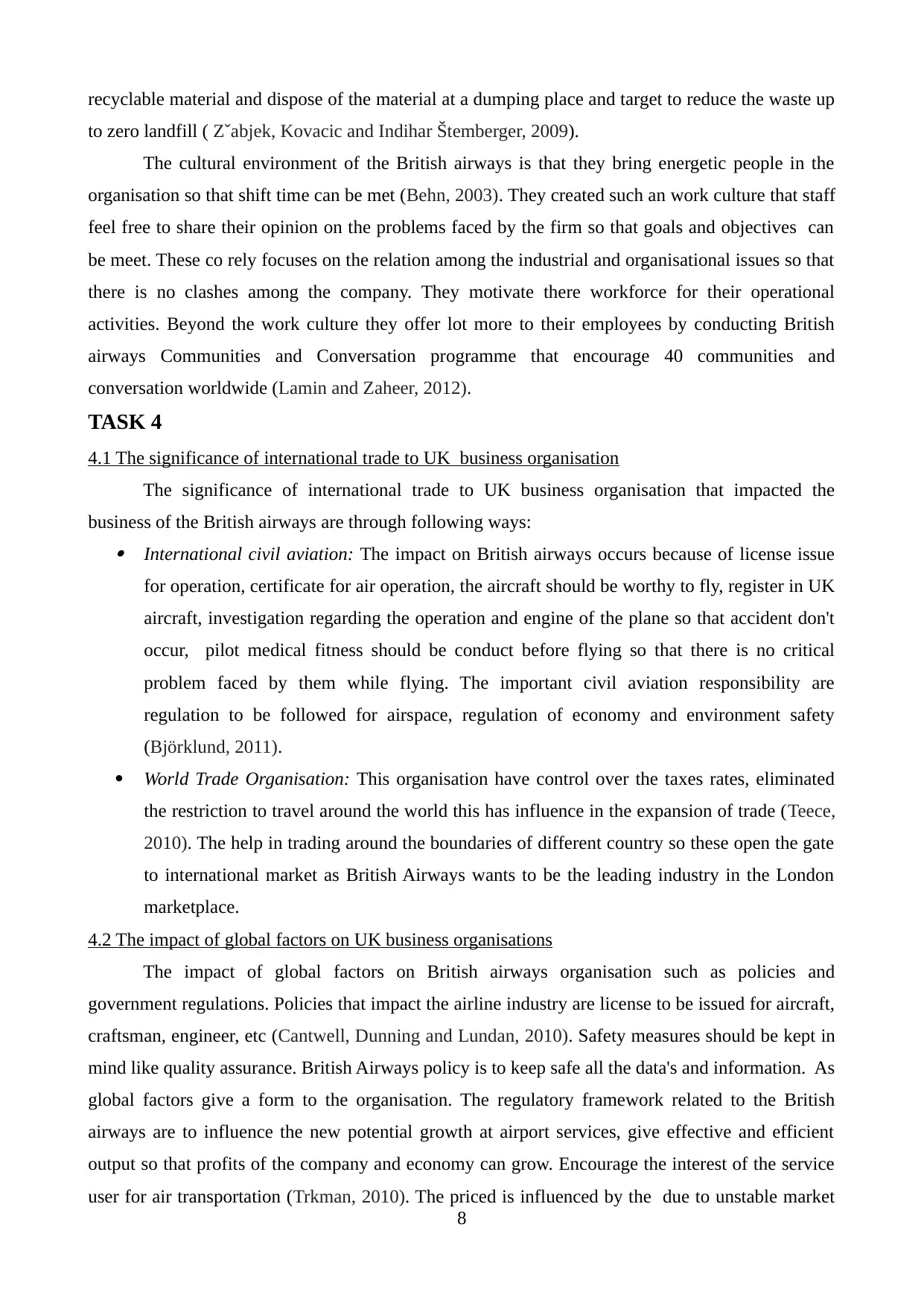
recyclable material and dispose of the material at a dumping place and target to reduce the waste up
to zero landfill ( Zˇabjek, Kovacic and Indihar Štemberger, 2009).
The cultural environment of the British airways is that they bring energetic people in the
organisation so that shift time can be met (Behn, 2003). They created such an work culture that staff
feel free to share their opinion on the problems faced by the firm so that goals and objectives can
be meet. These co rely focuses on the relation among the industrial and organisational issues so that
there is no clashes among the company. They motivate there workforce for their operational
activities. Beyond the work culture they offer lot more to their employees by conducting British
airways Communities and Conversation programme that encourage 40 communities and
conversation worldwide (Lamin and Zaheer, 2012).
TASK 4
4.1 The significance of international trade to UK business organisation
The significance of international trade to UK business organisation that impacted the
business of the British airways are through following ways: International civil aviation: The impact on British airways occurs because of license issue
for operation, certificate for air operation, the aircraft should be worthy to fly, register in UK
aircraft, investigation regarding the operation and engine of the plane so that accident don't
occur, pilot medical fitness should be conduct before flying so that there is no critical
problem faced by them while flying. The important civil aviation responsibility are
regulation to be followed for airspace, regulation of economy and environment safety
(Björklund, 2011).
World Trade Organisation: This organisation have control over the taxes rates, eliminated
the restriction to travel around the world this has influence in the expansion of trade (Teece,
2010). The help in trading around the boundaries of different country so these open the gate
to international market as British Airways wants to be the leading industry in the London
marketplace.
4.2 The impact of global factors on UK business organisations
The impact of global factors on British airways organisation such as policies and
government regulations. Policies that impact the airline industry are license to be issued for aircraft,
craftsman, engineer, etc (Cantwell, Dunning and Lundan, 2010). Safety measures should be kept in
mind like quality assurance. British Airways policy is to keep safe all the data's and information. As
global factors give a form to the organisation. The regulatory framework related to the British
airways are to influence the new potential growth at airport services, give effective and efficient
output so that profits of the company and economy can grow. Encourage the interest of the service
user for air transportation (Trkman, 2010). The priced is influenced by the due to unstable market
8
to zero landfill ( Zˇabjek, Kovacic and Indihar Štemberger, 2009).
The cultural environment of the British airways is that they bring energetic people in the
organisation so that shift time can be met (Behn, 2003). They created such an work culture that staff
feel free to share their opinion on the problems faced by the firm so that goals and objectives can
be meet. These co rely focuses on the relation among the industrial and organisational issues so that
there is no clashes among the company. They motivate there workforce for their operational
activities. Beyond the work culture they offer lot more to their employees by conducting British
airways Communities and Conversation programme that encourage 40 communities and
conversation worldwide (Lamin and Zaheer, 2012).
TASK 4
4.1 The significance of international trade to UK business organisation
The significance of international trade to UK business organisation that impacted the
business of the British airways are through following ways: International civil aviation: The impact on British airways occurs because of license issue
for operation, certificate for air operation, the aircraft should be worthy to fly, register in UK
aircraft, investigation regarding the operation and engine of the plane so that accident don't
occur, pilot medical fitness should be conduct before flying so that there is no critical
problem faced by them while flying. The important civil aviation responsibility are
regulation to be followed for airspace, regulation of economy and environment safety
(Björklund, 2011).
World Trade Organisation: This organisation have control over the taxes rates, eliminated
the restriction to travel around the world this has influence in the expansion of trade (Teece,
2010). The help in trading around the boundaries of different country so these open the gate
to international market as British Airways wants to be the leading industry in the London
marketplace.
4.2 The impact of global factors on UK business organisations
The impact of global factors on British airways organisation such as policies and
government regulations. Policies that impact the airline industry are license to be issued for aircraft,
craftsman, engineer, etc (Cantwell, Dunning and Lundan, 2010). Safety measures should be kept in
mind like quality assurance. British Airways policy is to keep safe all the data's and information. As
global factors give a form to the organisation. The regulatory framework related to the British
airways are to influence the new potential growth at airport services, give effective and efficient
output so that profits of the company and economy can grow. Encourage the interest of the service
user for air transportation (Trkman, 2010). The priced is influenced by the due to unstable market
8
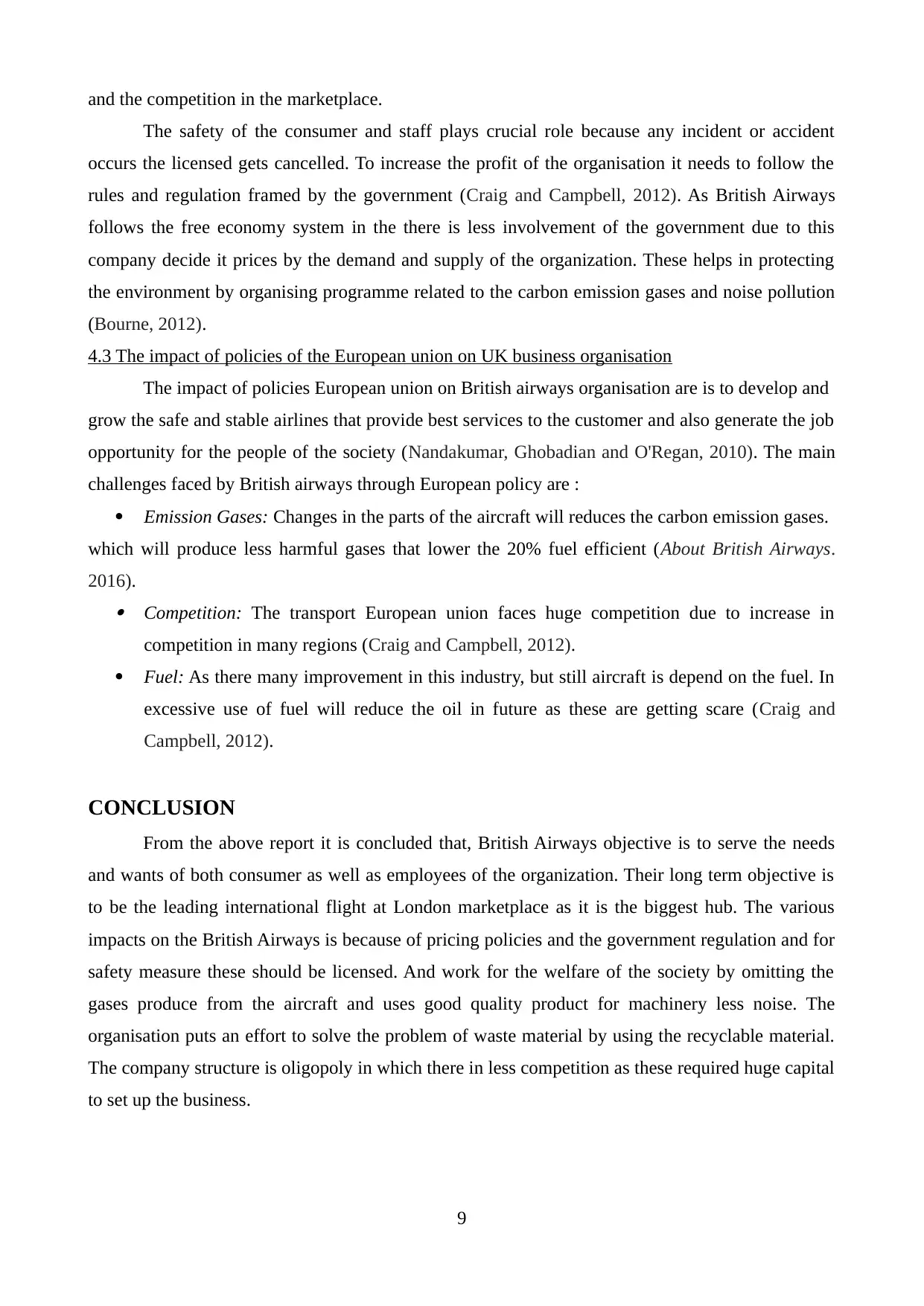
and the competition in the marketplace.
The safety of the consumer and staff plays crucial role because any incident or accident
occurs the licensed gets cancelled. To increase the profit of the organisation it needs to follow the
rules and regulation framed by the government (Craig and Campbell, 2012). As British Airways
follows the free economy system in the there is less involvement of the government due to this
company decide it prices by the demand and supply of the organization. These helps in protecting
the environment by organising programme related to the carbon emission gases and noise pollution
(Bourne, 2012).
4.3 The impact of policies of the European union on UK business organisation
The impact of policies European union on British airways organisation are is to develop and
grow the safe and stable airlines that provide best services to the customer and also generate the job
opportunity for the people of the society (Nandakumar, Ghobadian and O'Regan, 2010). The main
challenges faced by British airways through European policy are :
Emission Gases: Changes in the parts of the aircraft will reduces the carbon emission gases.
which will produce less harmful gases that lower the 20% fuel efficient (About British Airways.
2016). Competition: The transport European union faces huge competition due to increase in
competition in many regions (Craig and Campbell, 2012).
Fuel: As there many improvement in this industry, but still aircraft is depend on the fuel. In
excessive use of fuel will reduce the oil in future as these are getting scare (Craig and
Campbell, 2012).
CONCLUSION
From the above report it is concluded that, British Airways objective is to serve the needs
and wants of both consumer as well as employees of the organization. Their long term objective is
to be the leading international flight at London marketplace as it is the biggest hub. The various
impacts on the British Airways is because of pricing policies and the government regulation and for
safety measure these should be licensed. And work for the welfare of the society by omitting the
gases produce from the aircraft and uses good quality product for machinery less noise. The
organisation puts an effort to solve the problem of waste material by using the recyclable material.
The company structure is oligopoly in which there in less competition as these required huge capital
to set up the business.
9
The safety of the consumer and staff plays crucial role because any incident or accident
occurs the licensed gets cancelled. To increase the profit of the organisation it needs to follow the
rules and regulation framed by the government (Craig and Campbell, 2012). As British Airways
follows the free economy system in the there is less involvement of the government due to this
company decide it prices by the demand and supply of the organization. These helps in protecting
the environment by organising programme related to the carbon emission gases and noise pollution
(Bourne, 2012).
4.3 The impact of policies of the European union on UK business organisation
The impact of policies European union on British airways organisation are is to develop and
grow the safe and stable airlines that provide best services to the customer and also generate the job
opportunity for the people of the society (Nandakumar, Ghobadian and O'Regan, 2010). The main
challenges faced by British airways through European policy are :
Emission Gases: Changes in the parts of the aircraft will reduces the carbon emission gases.
which will produce less harmful gases that lower the 20% fuel efficient (About British Airways.
2016). Competition: The transport European union faces huge competition due to increase in
competition in many regions (Craig and Campbell, 2012).
Fuel: As there many improvement in this industry, but still aircraft is depend on the fuel. In
excessive use of fuel will reduce the oil in future as these are getting scare (Craig and
Campbell, 2012).
CONCLUSION
From the above report it is concluded that, British Airways objective is to serve the needs
and wants of both consumer as well as employees of the organization. Their long term objective is
to be the leading international flight at London marketplace as it is the biggest hub. The various
impacts on the British Airways is because of pricing policies and the government regulation and for
safety measure these should be licensed. And work for the welfare of the society by omitting the
gases produce from the aircraft and uses good quality product for machinery less noise. The
organisation puts an effort to solve the problem of waste material by using the recyclable material.
The company structure is oligopoly in which there in less competition as these required huge capital
to set up the business.
9
⊘ This is a preview!⊘
Do you want full access?
Subscribe today to unlock all pages.

Trusted by 1+ million students worldwide

10
Paraphrase This Document
Need a fresh take? Get an instant paraphrase of this document with our AI Paraphraser

REFERENCES
Books and journals
Aswathappa, K., 2009. Essentials of business environment. Himalaya Publishing House.
Behn, R. D., 2003. Why measure performance? Different purposes require different measures.
Public administration review. 63(5). pp.586-606.
Björklund, M., 2011. Influence from the business environment on environmental purchasing—
Drivers and hinders of purchasing green transportation services. Journal of Purchasing
and Supply Management. 17(1). pp.11-22.
Bourne, L., 2012. Stakeholder relationship management: a maturity model for organisational
implementation. Gower Publishing, Ltd..
Cantwell, J., Dunning, J.H. and Lundan, S.M., 2010. An evolutionary approach to understanding
international business activity: The co-evolution of MNEs and the institutional
environment. Journal of International Business Studies. 41(4). pp.567-586.
Carroll, A. and Buchholtz, A., 2014. Business and society: Ethics, sustainability, and stakeholder
management. Cengage Learning.
Carroll, A. B. and Shabana, K. M., 2010. The business case for corporate social responsibility: a
review of concepts, research and practice. International Journal of Management Reviews.
12(1). pp.85-105.
Craig, T. and Campbell, D., 2012. Organisations and the business environment. Routledge.
Hamilton, L. and Webster, P., 2015. The international business environment. Oxford University
Press.
Kessler, A. and Frank, H., 2009. Nascent entrepreneurship in a longitudinal perspective The impact
of person, environment, resources and the founding process on the decision to start
business activities. International Small Business Journal. 27(6). pp.720-742.
Lamin, A. and Zaheer, S., 2012. Wall street vs. main street: Firm strategies for defending legitimacy
and their impact on different stakeholders. Organization Science. 23(1). pp.47-66.
Loorbach, D., van Bakel, J.C., Whiteman, G. and Rotmans, J., 2010. Business strategies for
transitions towards sustainable systems. Business Strategy and the Environment. 19(2).
pp.133-146.
Nandakumar, M. K., Ghobadian, A. and O'Regan, N., 2010. Business-level strategy and
performance: The moderating effects of environment and structure. Management Decision.
48(6). pp.907-939.
Sim, A. B. and Teoh, H. Y., 2011. Relationships between business strategy, environment and
controls: a three country study. Journal of Applied Business Research (JABR). 13(4).
pp.57-74.
Teece, D.J., 2010. Business models, business strategy and innovation. Long range planning. 43(2).
pp.172-194.
Trkman, P., 2010. The critical success factors of business process management. International
Journal of Information Management. 30(2). pp.125-134.
Zˇabjek, D., Kovacic, A. and Indihar Štemberger, M., 2009. The influence of business process
management and some other CSFs on successful ERP implementation. Business Process
Management Journal. 15(4). pp.588-608.
Online
About British Airways. 2016. [Online]. Available through:
<http://www.britishairways.com/en-gi/information/about-ba>. [Accessed on 29th Janurary
2016].
Matching capacity to demand. 2010. [PDF]. Available through:
11
Books and journals
Aswathappa, K., 2009. Essentials of business environment. Himalaya Publishing House.
Behn, R. D., 2003. Why measure performance? Different purposes require different measures.
Public administration review. 63(5). pp.586-606.
Björklund, M., 2011. Influence from the business environment on environmental purchasing—
Drivers and hinders of purchasing green transportation services. Journal of Purchasing
and Supply Management. 17(1). pp.11-22.
Bourne, L., 2012. Stakeholder relationship management: a maturity model for organisational
implementation. Gower Publishing, Ltd..
Cantwell, J., Dunning, J.H. and Lundan, S.M., 2010. An evolutionary approach to understanding
international business activity: The co-evolution of MNEs and the institutional
environment. Journal of International Business Studies. 41(4). pp.567-586.
Carroll, A. and Buchholtz, A., 2014. Business and society: Ethics, sustainability, and stakeholder
management. Cengage Learning.
Carroll, A. B. and Shabana, K. M., 2010. The business case for corporate social responsibility: a
review of concepts, research and practice. International Journal of Management Reviews.
12(1). pp.85-105.
Craig, T. and Campbell, D., 2012. Organisations and the business environment. Routledge.
Hamilton, L. and Webster, P., 2015. The international business environment. Oxford University
Press.
Kessler, A. and Frank, H., 2009. Nascent entrepreneurship in a longitudinal perspective The impact
of person, environment, resources and the founding process on the decision to start
business activities. International Small Business Journal. 27(6). pp.720-742.
Lamin, A. and Zaheer, S., 2012. Wall street vs. main street: Firm strategies for defending legitimacy
and their impact on different stakeholders. Organization Science. 23(1). pp.47-66.
Loorbach, D., van Bakel, J.C., Whiteman, G. and Rotmans, J., 2010. Business strategies for
transitions towards sustainable systems. Business Strategy and the Environment. 19(2).
pp.133-146.
Nandakumar, M. K., Ghobadian, A. and O'Regan, N., 2010. Business-level strategy and
performance: The moderating effects of environment and structure. Management Decision.
48(6). pp.907-939.
Sim, A. B. and Teoh, H. Y., 2011. Relationships between business strategy, environment and
controls: a three country study. Journal of Applied Business Research (JABR). 13(4).
pp.57-74.
Teece, D.J., 2010. Business models, business strategy and innovation. Long range planning. 43(2).
pp.172-194.
Trkman, P., 2010. The critical success factors of business process management. International
Journal of Information Management. 30(2). pp.125-134.
Zˇabjek, D., Kovacic, A. and Indihar Štemberger, M., 2009. The influence of business process
management and some other CSFs on successful ERP implementation. Business Process
Management Journal. 15(4). pp.588-608.
Online
About British Airways. 2016. [Online]. Available through:
<http://www.britishairways.com/en-gi/information/about-ba>. [Accessed on 29th Janurary
2016].
Matching capacity to demand. 2010. [PDF]. Available through:
11
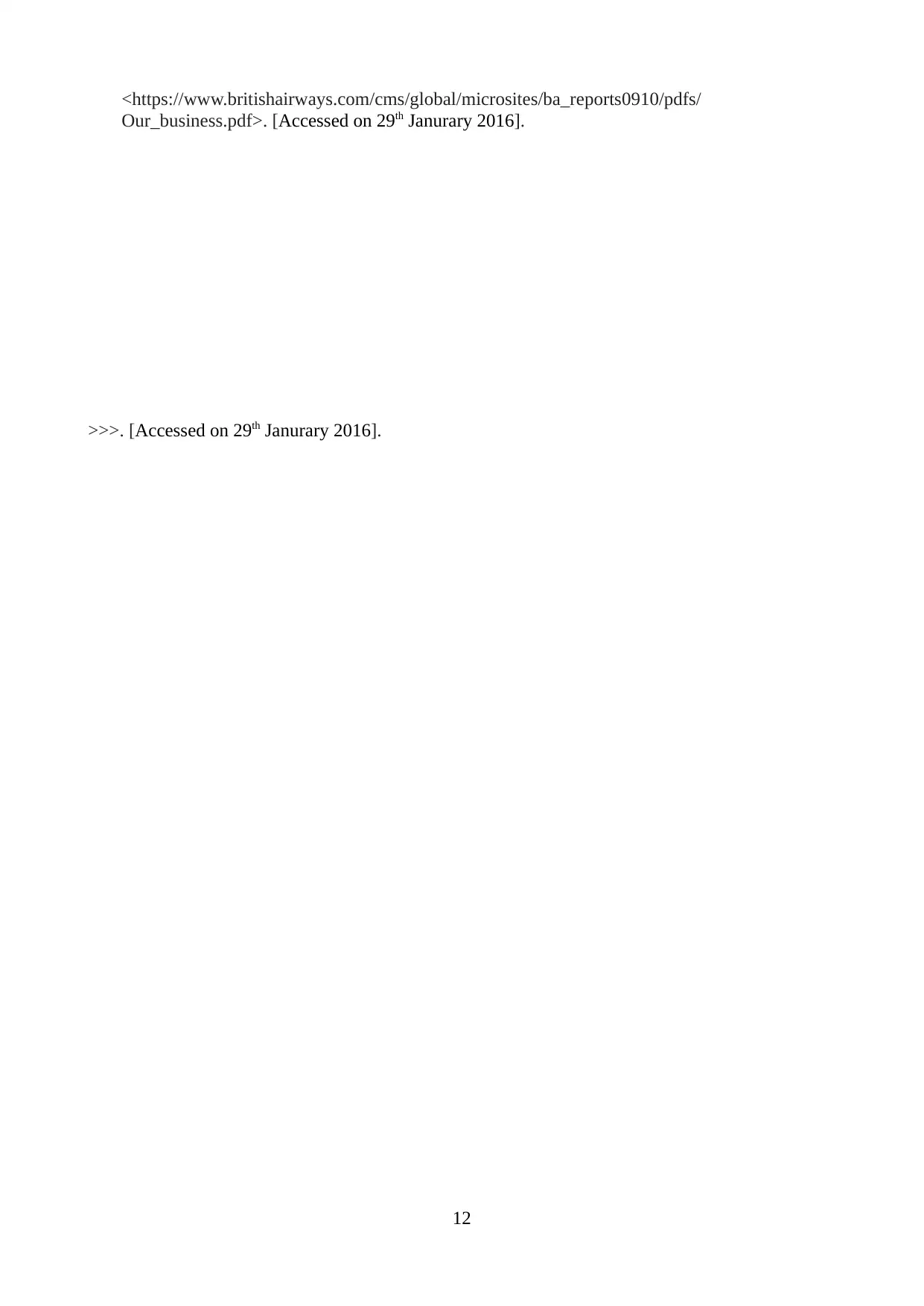
<https://www.britishairways.com/cms/global/microsites/ba_reports0910/pdfs/
Our_business.pdf>. [Accessed on 29th Janurary 2016].
>>>. [Accessed on 29th Janurary 2016].
12
Our_business.pdf>. [Accessed on 29th Janurary 2016].
>>>. [Accessed on 29th Janurary 2016].
12
⊘ This is a preview!⊘
Do you want full access?
Subscribe today to unlock all pages.

Trusted by 1+ million students worldwide
1 out of 12
Related Documents
Your All-in-One AI-Powered Toolkit for Academic Success.
+13062052269
info@desklib.com
Available 24*7 on WhatsApp / Email
![[object Object]](/_next/static/media/star-bottom.7253800d.svg)
Unlock your academic potential
Copyright © 2020–2025 A2Z Services. All Rights Reserved. Developed and managed by ZUCOL.





